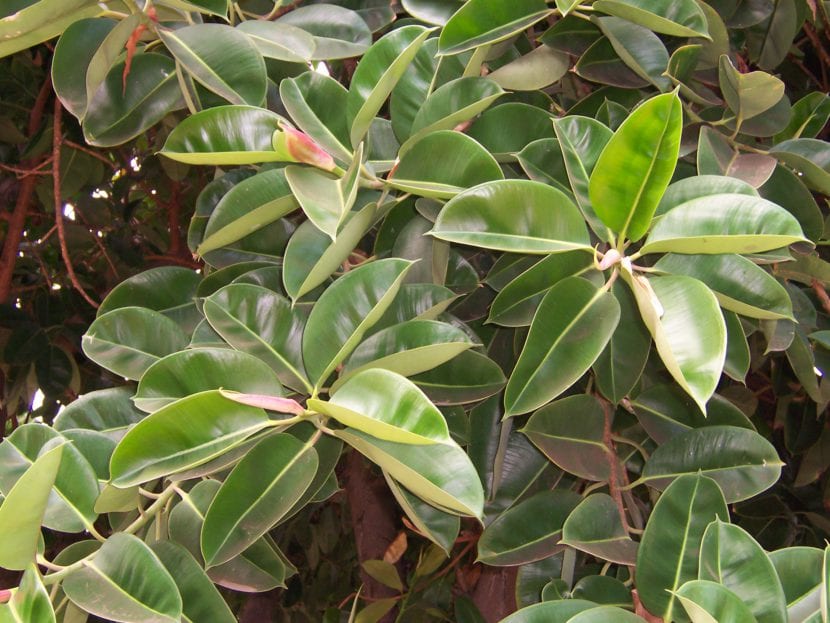
This is a very popular tree in the interior of homes. And no wonder: its leaves are large and can be both one color (green) and several (green and yellow). Its growth rate is also slower than that of other species of the genus, so they can be kept for several years in a pot smoothly.
His scientific name is Ficus elastica, although it is much better known by its other names, such as Tree of Rubber or Gomero. If you want to know everything about him, you've come to the right place. After reading this article you will know its care, how it reproduces, and much, much more.
Characteristics of the rubber tree
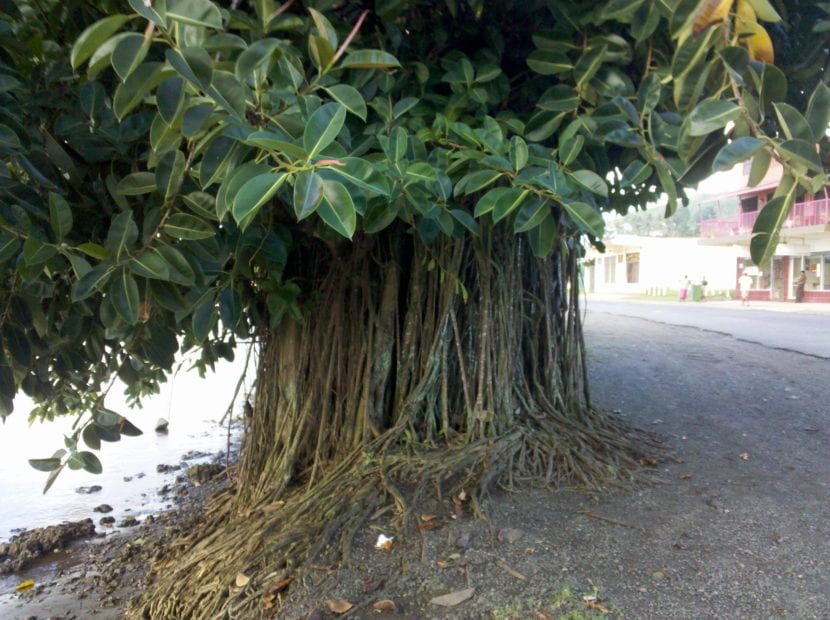
Originally from India, the Ficus elastica It is a tree of the so-called epiphytes, which develops a trunk and also roots that grow in such a way that they form a pillar solid enough for the plant to support itself. It is not a parasite, as is the ficus benghalensis, but it is true that the roots are very invasive and that, therefore, if we want to have it in the garden we will have to take a series of precautions that we will see later.
Now, we are going to focus on its characteristics, on what distinguishes it from others of its kind. Let's start, how could it be otherwise, with the leaves. The leaves of this plant are perennial, and large, up to 30cm long. Normally, they are of a bright green color, but as we said, there are also those that are variegated, which are hybrids from the Ficus elastica Robusta, which have wider and more rigid leaves. As a curiosity to say that nothing else sprouts, before opening, They are red that are losing as they open up and finish developing.
It does not have decorative flowers. In fact, its pollinator is a fig wasp, and since this insect does not have a very good sense of smell and cannot distinguish colors well, the tree does not waste energy producing beautiful flowers. Once it has been pollinated, the fig is developed, which is 1cm long and is greenish-yellow in color that is not very edible.
Gomero care
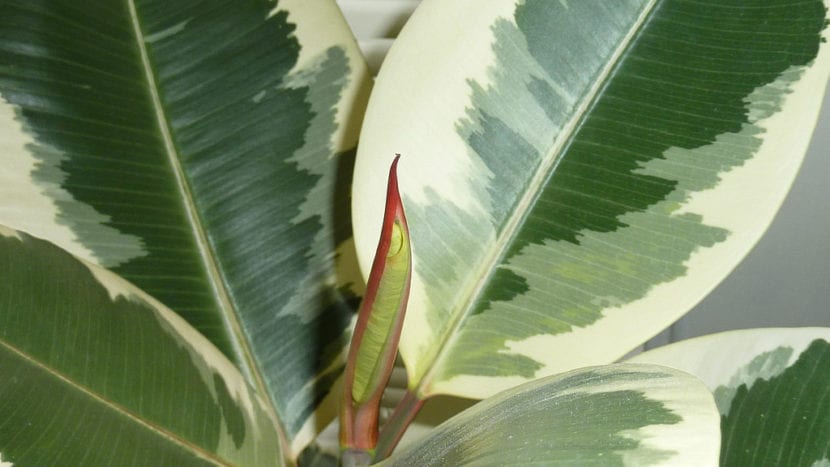
Are you thinking of having a rubber tree? These are the care your plant will need:
Location
Whenever possible, it will be more advisable to put it outside, in full sun. But keep in mind that is sensitive to frost, being able to withstand only those that are soft (up to -2ºC) and of short duration. In addition, it needs a lot of space to grow, so it has to be planted at a minimum distance of 10m from any construction and any irrigation system.
Inside the home It should be put in a room where a lot of natural light enters, away from air currents (both cold and warm), and also away from areas of passage, since the continuous rubbing would damage the tips of the leaves.
Irrigation
Irrigation has to be frequent, especially in summer which is when the tree grows faster and faster. Thus, it will be watered between 3 and 4 times a week in summer if it is in the garden and 2 if it is at home, and the rest of the year once or twice every 6-7 days.
Subscriber
It is not advisable to pay, because its roots grow quickly without the need to make an extra supply of nutrients.
Pruning
It can be pruned in spring and summer, but it is important to put ash on the cuts as soon as they are done to prevent too much latex from coming out.
Transplant
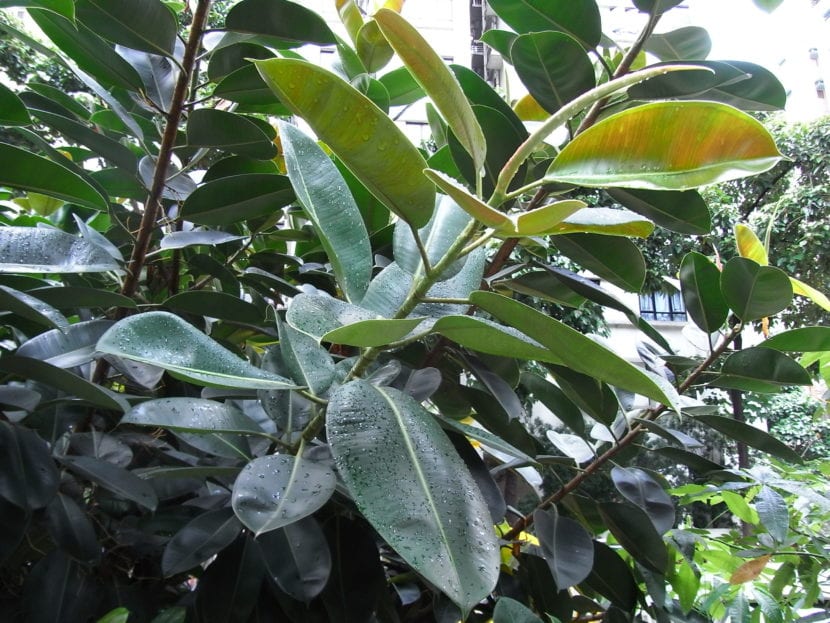
Whether you want to move to a larger pot or to the garden, it must be done in spring, after the risk of frost has passed.
To pot
To transfer the gum tree to a larger pot, you simply have to do the following:
- Take a pot that is about 5cm wider than the »old one».
- Fill it with a little universal growing medium mixed with 20% perlite.
- Remove the tree from the pot. If you see that you can't, hit it on different sides.
- Put the plant in its new pot.
- Finish filling your new pot with more substrate.
- And finally he waters.
To the garden
To pass the Elastic Ficus directly to the garden, you have to:
- Make a planting hole deep enough to fit well.
- Water it well, so that the soil is well soaked.
- Remove the tree from the pot.
- Place it inside the hole and fill it with garden soil mixed with universal substrate.
- Water.
Plagues and diseases
This is a very hardy tree, but it can be attacked by fungi and nematodes that damage their roots. For this reason, it is worth doing preventive treatments with copper or sulfur for fungi and with Neem oil for nematodes during the growing season (spring and summer).
Reproduction of the rubber tree
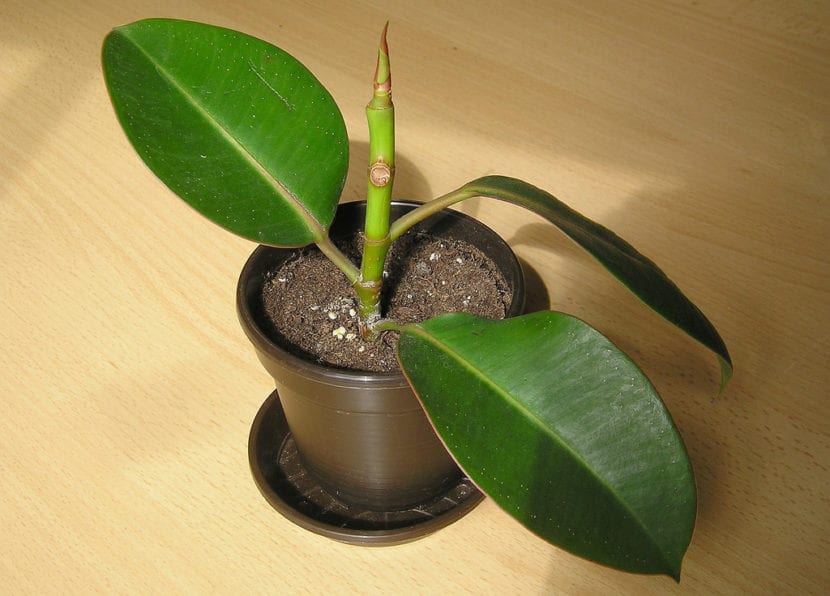
How does this tree reproduce? Actually, in a very simple way: by apical cutting in spring or summer. To do this, you must cut a branch of about 20cm, and plant it in a pot with porous substrate, such as black peat and perlite in equal parts, for example, as they did with the one you can see in the image above.
To make sure that it will go well you can, before planting it, moisten the base with water and then impregnate it with rooting hormones. Afterward, always keep it moist but not watery, and within a month it will begin to grow roots.
Uses
It is a plant that is normally used as an ornamental, either as an isolated specimen to give a little shade to the garden, or as an indoor plant, but you should also know that its latex is used to make chewing gum, which is why it is called gomero.
Of course, prevent your skin from coming into contact with this sap because it is very irritating.
Can you make a bonsai from Ficus elastica?
Yes you can, but It is very difficult. The first thing to do is reduce the size of the leaves, by pinching during the growing season, and then prune it to shape. It's not easy at all, but sometimes you get interesting jobs. 🙂
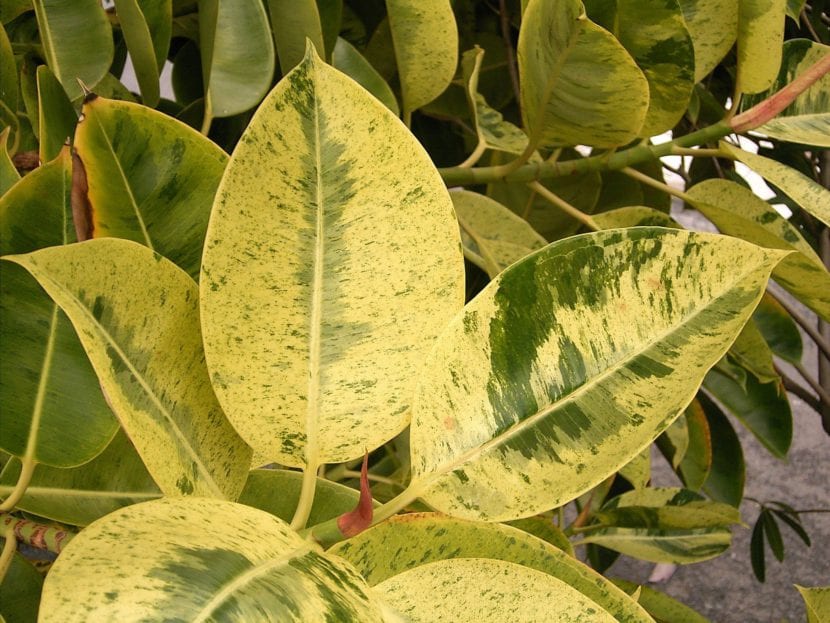
And so far the special of one of the most interesting trees to have indoors. What do you think? Do you dare to have one at home or in the garden? 🙂
excellent the site continues to inform us about plants and how to care for them and their properties
We're glad you like it, Marta. 🙂
Its latex was used to make rubber, but for industrial uses, such as tires, it has nothing to do with the food grade rubber used to make chewing gum. The latex of this plant, as you say, is very irritating to the skin, especially the eyes and its toxicity is fatal if ingested, so please, edit the post or you may be responsible for someone being poisoned.
Even to make rubber, given its toxicity, it is currently preferred to extract the latex from Hevea brasilensis.
Chicle (from Nahuatl tzictli) is a gummy polymer obtained from the sap of the Manilkara zapota tree of the sapotáceas family (formerly called Sapota zapotilla or Achras zapota) native to Mexico, Central America and tropical South America. It is also commonly known as chicozapote or acana. While most of today's chewing gums use a neutral plastic base, also known as polyvinyl acetate, or also xanthan gum.
Regarding the uses of this tree, this very important tree for the ecosystem in its natural habitat, where it can be pollinated by its respective species of fig wasp, is the only insect that can pollinate it, so that it bears fruit throughout throughout the year and is essential in the diet of numerous species of birds and mammals, including several species of primates.
Another use, not so important, but very surprising, is that of the members of the Khasi tribe, who live in the area of Cherrapunji, Meghalaya state, in India. The Khasi cultivate these trees, mold and care for them for generations, to build the Living Bridges. This bio-construction technique cannot be missed, as it is part of one of the most important traditions on our planet.
I hope you like one of the videos that I found - https://www.youtube.com/watch?v=4fm1B9-oavU
Hello. I would like to know if the elastic FIcus wasp (Blastophaga clavigera) has arrived in Mexico. I know it is already present in Florida.
Thank you
Hello Alberto.
I've been looking for information, but haven't found anything about it.
It may not have arrived yet.
A greeting.
It is very easy to know if the wasp has arrived in your area, if the Ficus elastica in your area have figs the wasp is already there, because if it had not arrived the ficus would not bear fruit. The figs of this species are greenish-yellow, oval and small, about 1 cm long.
In Spain they have also become naturalized, in the Canary Islands and more specifically in La Gomera, that is why we call this Rubber Tree here Gomero.
If the wasp has not arrived, there are 22 naturalized Ficus varieties in Mexico.
- Ficus carica or common fig, there are self-fertile ones, (which do not need to be fertilized by the wasp) and they give two crops a year, one of figs and the other of figs, both edible and delicious ... if the birds do not arrive before you the harvests.
- Ficus religious, so called because it is the most sacred tree in Buddhism, Hinduism and Jainism. According to the Buddhist tradition, Siddhartha Gautama reached nirvana (becoming the first Buddha) after having been meditating under a tree of this species which they called Bodhi, from his cuttings other trees were planted, such as Sri Maha Bodhi, which is in Anuradhapura, Sri Lanka and whose record shows that it was planted in 288 BC. C. still lives, because the trees of this variety last for millennia. It has highly prized heart-shaped leaves, they can be dried and preserve only the web formed by the ribs, in India they use them to paint on them images of their gods and sacred animals that they then frame or offer as gifts and religious offerings. Figs are small and red in color, they are not edible for humans, but there are animals that like them.
- But there are also 3 species of Ficus that are endemic to your country, Ficus lapathifolia, F. petiolaris and F. pringlei. These are the ones that I would advise you to plant especially, since they could become extinct, (trees or wasps), as they are not found in other countries. Being endemic you ensure that they will bear fruit, to help maintain the population of native animals that feed on their figs.
I hope I've been of some help.
Hello, very good information !! I would like to know what another type of tree I can plant in my house, since I live in the province of San Juan, it is a city where the temperatures are changeable and the summer is hot ...
Hi carlos.
Are you from Argentina, right?
If so, what kind of trees do you like? For now, I recommend these, which do not have invasive roots:
-Cercis siliquastrum (deciduous)
-Prunus pissardii (deciduous)
-Viburnum lucidum (evergreen)
-Bauhinia variegata (deciduous)
-Polygala (it is an evergreen shrub and decorative flowers)
A greeting.
In your province there is an oasis !!
I visited the oases of Tunisia, they cultivate on 3 levels, the tall date palms form the roof and provide shade for the crops that shelter under them: olive trees and other fruit trees form the second level, the third level is formed by the vegetable plantations and vegetables.
In Permaculture we cultivate forest gardens too, but on 7 levels. In the 3rd level bushes, hazelnut, blackberry, raspberries, etc. The 4th and 5th level are made up of perennial vegetables, such as mallow or nettle that fix nitrogen, they are associated with other plants that need it, such as short-cycle vegetables such as spinach, cabbages, etc. Also with aromatic herbs that control pests and plant diseases such as Taguetes, thyme, rosemary, lavender, etc. The 6th level is made up of the climbing plants, in your region the most appropriate is the vine and the climbing legumes, surely you can also plant vegetable sponges, the loofah, cut into discs are very useful in hydroponic and aeroponic cultivation. The 7th level is made up of creeping plants: pumpkin, melon, watermelon, wild strawberries ...
I would plant all these things on my land rather than a plant for merely ornamental use. After all, a fig tree is just as beautiful as a ficus and at the moment I prefer figs to rubber (the fauna in my area too). For the same reasons, I prefer a Plum to an ornamental Prunus and I prefer a Moringa or a Chaya or a tea or mate bush to any other evergreen plant but whose leaves cannot be eaten as a vegetable or to make an infusion.
Those at the top of the food pyramid design crises in a cyclical way, because when those at the bottom die they take the opportunity to eat them. That the next one does not catch us with an ornamental garden.
Of course, if you have hectares of land left over, go to the Town Hall, make an appointment with the agronomist of your city and ask for advice, who will tell you which plants in the area are in danger of extinction and if he can provide you with the address of the Seed Bank, or give you a permit to get cuttings in the place that the authorities determine to facilitate them to those who want to plant them.
Hello
Can I transplant the pot and cut the same day or am I going to put a lot of stress on the plant? My gomero is already 15 years old!
Regards,
Hello Caroline.
I recommend you wait a month to make the cutting. This way the plant will not suffer so much.
A greeting.
Hello Caroline.
I recommend waiting 1 month after transplanting to make cuttings.
A greeting.
Hello friend, the article is very good, I have one in my house of about 9 meters beautiful, but I have noticed its leaves fall a lot and I see emptiness in its foliage, here we are entering the summer and I would like to know if you need something to make it full of beautiful leaves… thank you !!
Hello
I have a rubber tree of 2 to 3 meters approx. In my garden I have to remove it, it is very close to the house, I can transplant it, it is recommended, I do not want it to dry out as I do
Hi Luis.
You can remove it in spring, making four trenches of about 50cm deep each one at least and a hand saw that you will use to cut the roots (from the base of each trench).
Then you just have to plant it in a pot and give it a "haircut": trimming the branches a bit.
A greeting.
What size and color are the flowers of the gum tree?
Thank you.
Hi! I am not an expert in plants a few months ago I bought a silver for indoor but lately the leaves are down and I do not know what happens. Is she dead or is it that I have taken care of her badly. I would like to put a photo to see if you can help me to recover the plant because it was beautiful months ago.
Hello Ikram.
I recommend you send a photo to our Facebook profile, so we can help you.
All the best
Hello! Very good information, I live in the southern hemisphere and we are in the middle of summer. It is not clear to me if I can change the gum tree to a bigger pot at this time. Please can you tell me if it is possible? Thanks
Hi Angela.
Yes, you can do now.
A greeting.
I have a rubber tree in the garden, the ground is rising, I am afraid that it will break the water pipes, what can I do to make it dry or is there another solution?
Hi Claudia.
Here you have the information you ask for.
A greeting.
After I passed it to a wood the leaves were put
How burned is a new plant that I bought 15 days ago
Hello Miriam.
This happens when a plant that is not acclimatized is put in the sun.
You have to put it in semi-shade, and get used to the sun little by little.
Regards!